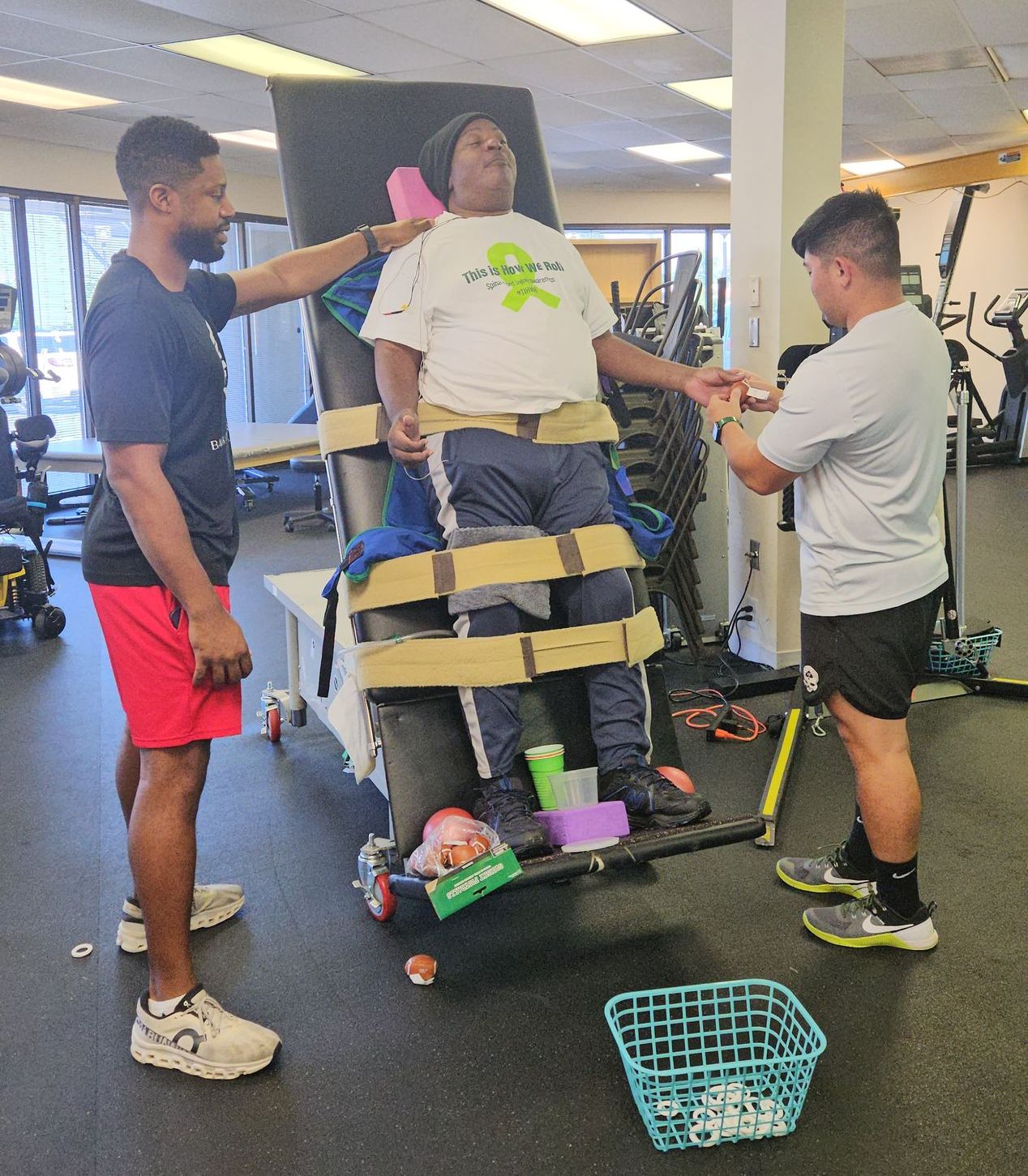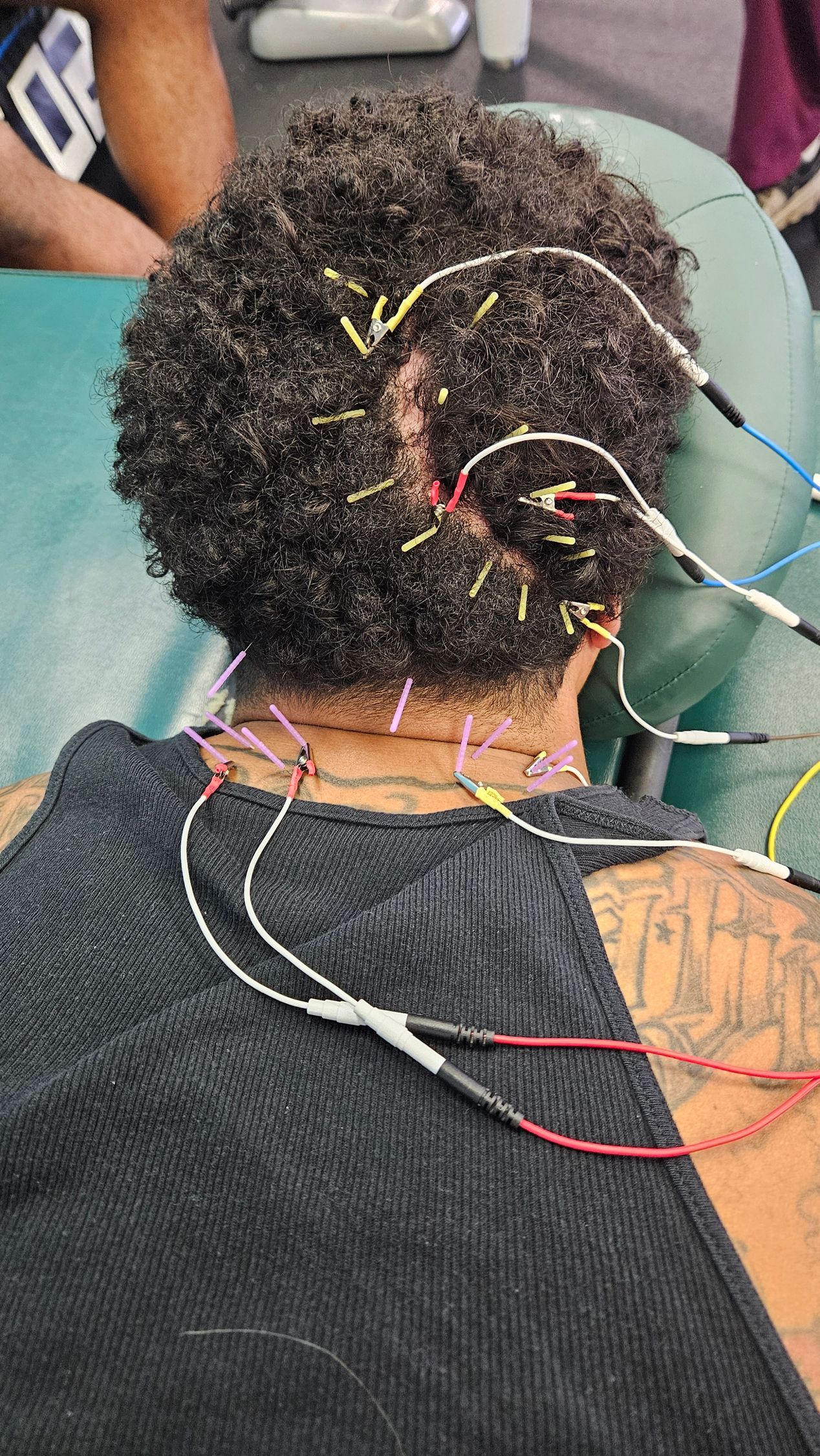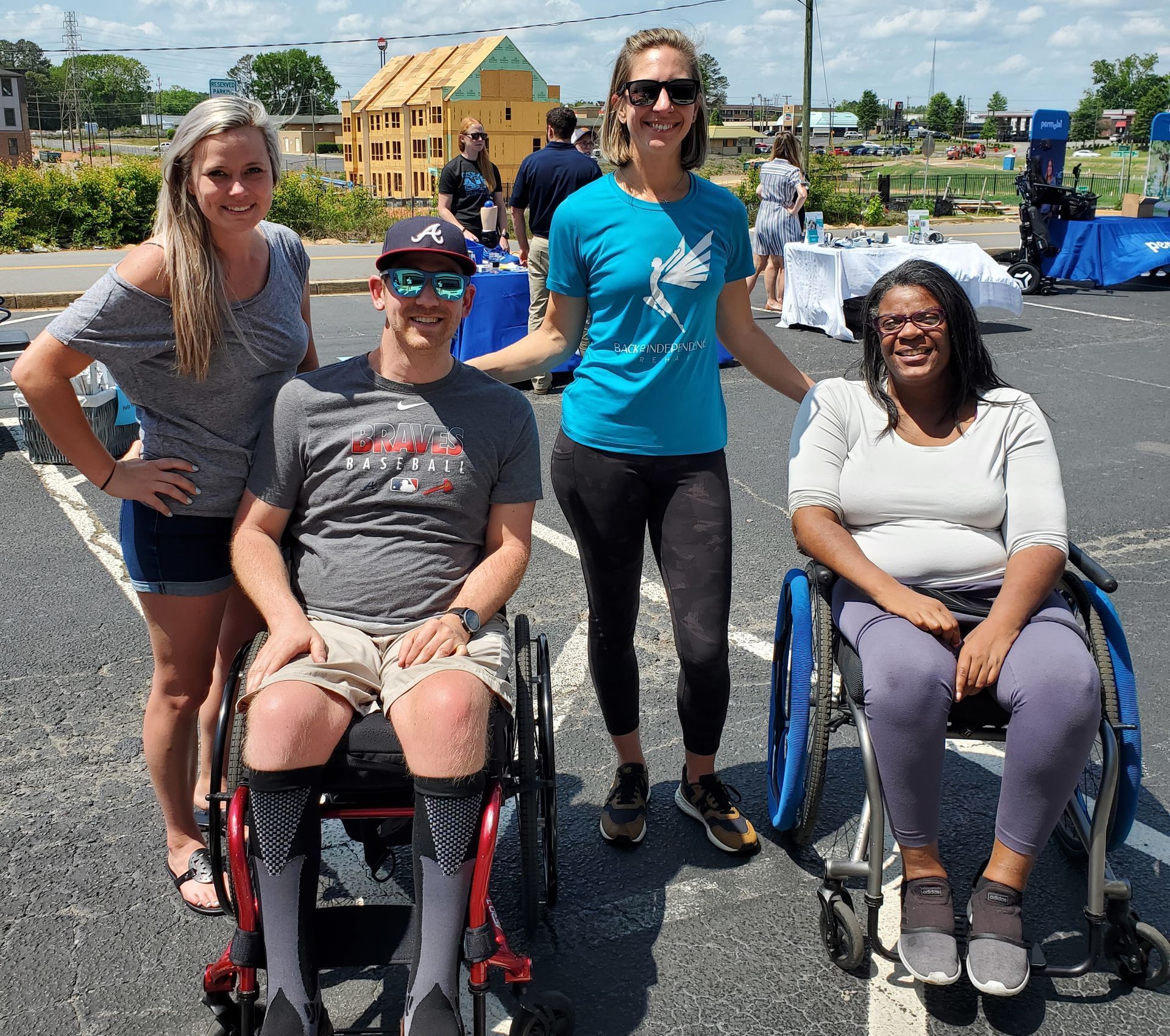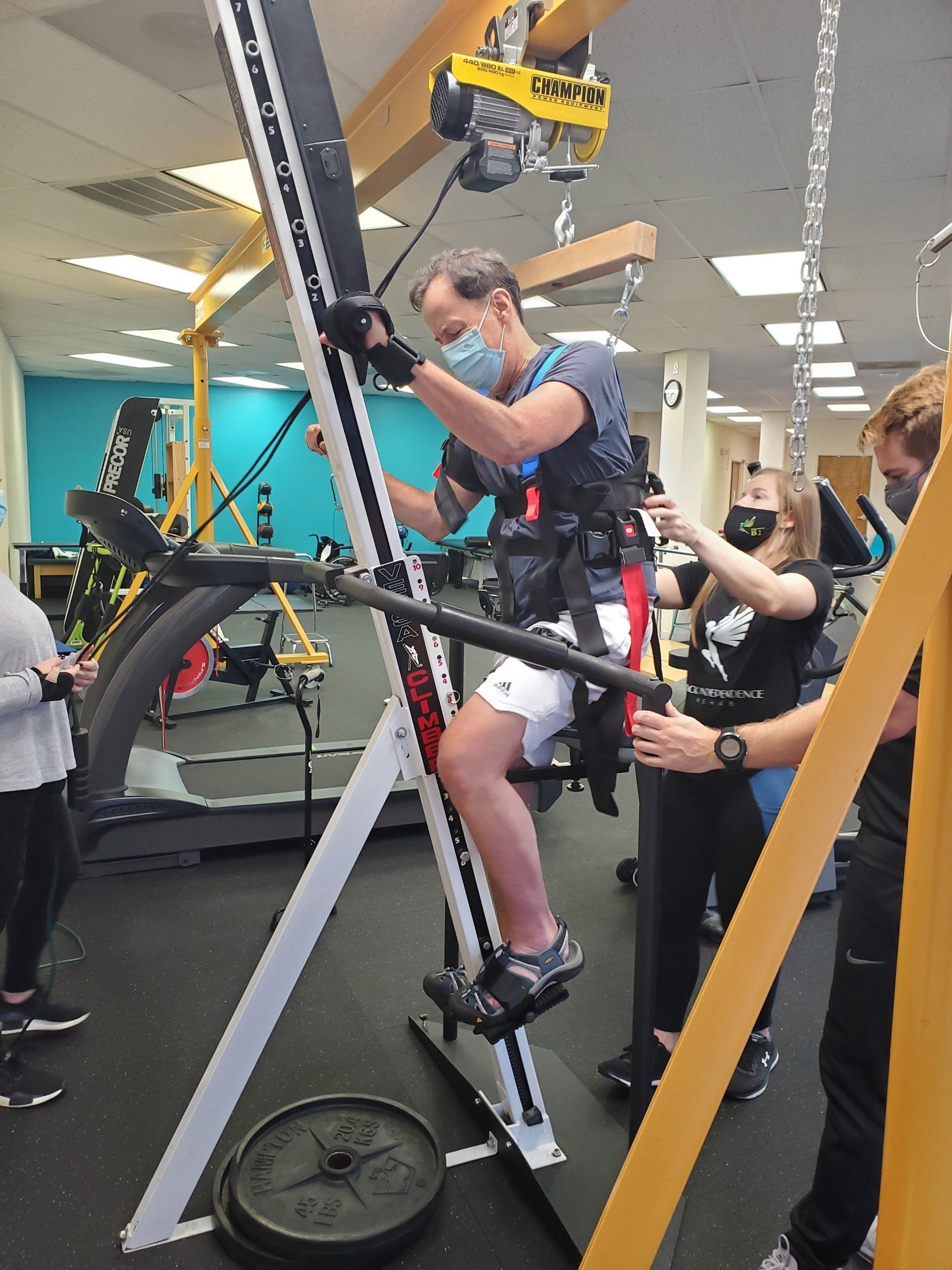Blog

Why Aquatic Therapy Is a Game-Changer for Neurological Recovery Recovering after a neurological injury—whether from spinal cord injury, stroke, traumatic brain injury, multiple sclerosis, or Parkinson’s disease—requires more than traditional exercise. The body and brain need consistent, targeted movement opportunities that promote neuroplasticity, the brain’s ability to rewire and form new connections. That’s where aquatic therapy comes in. Water provides a uniquely supportive and resistance-based environment that allows individuals to move more freely, safely, and effectively during their recovery journey. The Science Behind Water-Based Neuro Rehab Water’s natural buoyancy reduces the impact of gravity, decreasing pain and joint strain while increasing confidence in movement. For individuals with limited mobility or weakness, this means they can stand, walk, or exercise in ways not always possible on land. At the same time, water’s resistance provides gentle strengthening, balance, and endurance training—helping retrain the nervous system and activate muscle groups that may have gone dormant after injury. These consistent, low-impact repetitions are vital for improving motor control, coordination, and neuroplasticity. Benefits of Aquatic Therapy for Neurological Conditions Improves muscle activation and strength through water resistance Enhances balance and coordination with reduced fall risk Increases circulation to aid healing and flexibility Supports relaxation and reduces spasticity or tone Boosts confidence and independence through movement success Whether you’re rebuilding strength after a spinal cord injury or working to regain coordination post-stroke, aquatic therapy can accelerate progress and enhance well-being. Why Choose Back to Independence Rehab At Back to Independence Rehab, our Neuro Fitness Specialists are trained to design personalized aquatic therapy programs for each client’s goals and abilities. We focus on bridging the gap between therapy and lifelong wellness by offering accessible equipment, expert guidance, and a community that truly understands your journey. Our aquatic exercise sessions are not just workouts—they’re part of a holistic neuro recovery plan that integrates movement science, neuroplasticity, and wellness in one supportive environment. Take the Next Step Toward Recovery If you or a loved one is living with a neurological condition and looking to regain mobility, confidence, and independence—aquatic therapy can be your next breakthrough. 📅 Book a complimentary consultation to learn how our aquatic rehab sessions can fit into your recovery plan. Email info@btirehab.com or 📞 Call us at 980-335-0778 today!

For many in our community living with spinal cord injury, stroke, MS, and other neurological conditions, the goals are clear: feel less stiff, get stronger, move with more ease, and reconnect with your body. One tool we’ve added to training at Back to Independence Rehab is Transcutaneous Spinal Stimulation (TSS) —a non-invasive form of spinal neuromodulation delivered through adhesive electrodes on the skin while you practice task-specific movement. What TSS feels like here During sessions, we place small electrodes over specific spinal levels (cervical for arm/hand work, lumbosacral for trunk/leg work) and deliver carefully tuned pulses while you perform meaningful tasks—grip and reach, sit-to-stand, stepping, or balance practice. Most people describe the sensation as a strong, buzzy pressure that’s very tolerable. Our clinicians adjust parameters in real time based on your goals and comfort. What our community is noticing Without naming names, here are real themes we hear after a training block with TSS + active practice: • “I feel looser—less spastic and easier to stretch—so I can get moving sooner.” • “My hands feel more ‘online’—better pinch, quicker release, and more control during daily tasks.” • “I’m stronger and last longer in sessions; my steps feel more even.” • “I can find my body better—more sensation, better posture, and smoother transitions.” These stories line up with what researchers are finding. What the research says (in plain English) • Hand & arm improvements in cervical SCI : A large, multi-site clinical trial (the Up-LIFT study) reported that adding non-invasive spinal stimulation to structured rehab produced clinically meaningful gains in upper-limb strength, function, and sensation for many people with chronic tetraplegia—most participants improved, and quality-of-life scores rose as well. • Rapid, sometimes lasting gains after sessions : Earlier work showed fast improvements in reach, grasp, and pinch with cervical TSS in people with chronic SCI—some retained gains for months, suggesting real neuroplastic change (the nervous system “re-wiring” with practice). • Spasticity relief : Controlled studies indicate TSS can temporarily reduce spasticity in people with SCI—often enough to make stretching, positioning, and training easier. Newer mechanistic research points to enhanced spinal inhibitory circuits as a likely reason. • Walking & balance signals : In people with incomplete SCI, combining gait practice with TSS has been linked to better gait speed, endurance, and balance in emerging studies. There’s also preliminary evidence TSS can boost walking ability after stroke when paired with gait training. • Multiple sclerosis : Even a single session of lumbar TSS has shown reduced spasticity and improved walking performance in people with MS, with effects that can persist for hours. Bottom line : When TSS is paired with purposeful, repetitive practice, many people see less stiffness, more strength/control, and better functional movement—exactly what our members are reporting. Why pairing TSS with training matters TSS doesn’t move you by itself; it modulates the excitability of spinal networks so your own efforts (and the right tasks) “take” better. That’s why we always pair stimulation with functionally relevant work—gripping a real object, stepping patterns, postural control—while we scale difficulty, dosage, and rest. Who might benefit • Cervical SCI aiming to improve hand/arm control • Thoracic/lumbar or incomplete SCI working on trunk/leg function, balance, or gait • MS with spasticity and fatigue impacting walking • Select stroke survivors focusing on gait symmetry and speed (We screen for contraindications and collaborate with your medical team as needed.) What a session looks like at BTI Goal check & baseline : What matters most today—opening a jar, transfers, stairs, handwriting? Targeted electrode setup : Cervical or lumbosacral placement based on your goal. Parameter titration : We dial in frequency, intensity, and timing to support the task. Task-specific practice : High-repetition, coached movement while stimulation runs. Cool-down & reassess : Quick measures so you can feel/see change over time. Safety Across trials, non-invasive spinal stimulation has been well-tolerated, with most adverse events being minor skin irritation or temporary discomfort. Our team monitors skin, blood pressure, and overall tolerance, and we adjust quickly if anything feels off. ________________________________________ Frequently Asked Questions Q: Will the improvements last after TSS sessions? A: Research shows some gains—like better strength, coordination, and sensation—can last weeks or months, especially when combined with regular, targeted training. However, many people benefit from continued sessions to reinforce and build on progress. Q: Does it hurt? A: Most people describe the feeling as a strong buzzing or tapping under the electrodes—intense but not painful. We can adjust intensity and positioning to your comfort level. Q: How many sessions will I need? A: That depends on your goals, medical history, and response. Some feel changes after a single session, but research and our experience suggest consistent use over weeks produces the best outcomes. Q: Can I do TSS if I have metal implants or a baclofen pump? A: In most cases, yes—but we always review your medical history first and, if needed, coordinate with your physician. Q: Is TSS safe for everyone? A: We avoid TSS in people with certain heart devices, uncontrolled seizures, or skin issues at the electrode site. That’s why we screen carefully before starting. ________________________________________ Ready to Experience the Benefits of TSS? Start your recovery journey today with Back to Independence Rehab—where science, movement, and community meet. Whether your goal is to reduce spasticity, regain strength, or reconnect with your body, our expert team is here to guide you every step of the way. 💪 Call us today: 980-335-0778 📍 Visit us: Charlotte, NC 🔗 Book your session now Your path to greater strength, mobility, and confidence starts here. Let’s take the next step together toward your independence! 💙 ________________________________________ Selected references (open-access or abstracts) Non-invasive spinal cord electrical stimulation for arm and hand function in chronic tetraplegia: a safety and efficacy trial (Up-LIFT). Nature Medicine (2024). Transcutaneous spinal cord stimulation restores hand and arm function after SCI. IEEE TNSRE (2021) + follow-up durability data. Transcutaneous spinal cord stimulation induces temporary attenuation of spasticity in individuals with SCI. J Neurotrauma (2020). Targeted tSCS improves hand motor function: mechanisms paper. Journal of Neurophysiology (2024). tSCS enhances walking performance and reduces spasticity in MS. Brain Sciences (2021). tSCS paired with gait training improves walking after stroke (case-series). BioMedical Engineering OnLine (2024).

At Back to Independence Rehab, we believe in empowering individuals with neurological conditions and mobility impairments to achieve their highest level of function and independence. That’s why we integrate cutting-edge rehab techniques, including dry needling, to support pain relief, neuromuscular recovery, spasticity and overall wellness. But what exactly is dry needling, and how can it help YOU on your rehab journey? Let’s break it down. ________________________________________ What is Dry Needling? Dry needling is a specialized evidence-based therapy that uses thin, sterile needles to target trigger points (knots in the muscle), tendons, and connective tissues. Unlike acupuncture, which follows traditional Chinese medicine principles, dry needling is based on modern neurophysiology and musculoskeletal science to promote pain relief, improved mobility, and muscle function. The Benefits of Dry Needling in Neuro Rehab If you are living with spinal cord injury (SCI), stroke, multiple sclerosis (MS), cerebral palsy (CP), Parkinson’s disease, or other neuromuscular conditions, dry needling can: ✅ Reduce Spasticity & Muscle Tightness – Helps relax overactive muscles, improving range of motion and flexibility. ✅ Decrease Pain & Discomfort – Targets areas of chronic pain to improve daily function. ✅ Enhance Neuromuscular Function – Stimulates nerve-muscle communication, aiding in functional movement. ✅ Improve Circulation & Recovery – Boosts oxygen flow to promote healing and reduce fatigue. ________________________________________ How Dry Needling Fits into Your Rehab Plan At Back to Independence Rehab, we don’t believe in a one-size-fits-all approach. Our Neuro Fitness Specialists and Occupational Therapists develop personalized treatment plans that may combine dry needling with strength training, aquatic therapy, mobility exercises, and functional rehab to help you reach your maximum potential. Who Can Benefit from Dry Needling 🔹 Individuals with spinal cord injuries, brain injuries or disabilities experiencing spasticity or muscle tightness 🔹 Stroke survivors dealing with neuromuscular dysfunction or movement limitations 🔹 Those with chronic pain, myofascial trigger points, or overactive muscles 🔹 Athletes and active individuals recovering from injuries or muscle imbalances 💡 Not sure if dry needling is right for you? Our specialists will assess your unique rehab needs and determine the best treatment approach. ________________________________________ Why Choose Back to Independence Rehab? 🌟 Specialized for the Disability Community – We are Charlotte’s premier adaptive rehab gym, designed specifically for individuals with neurological conditions and mobility challenges. 🌟 Expert Neuro Fitness & Rehab Specialists – Our team stays on the cutting edge of neuro rehab, integrating proven therapies like dry needling, functional strength training, and adaptive fitness. 🌟 A Community That Cares – More than just a gym, we are a supportive community that understands the challenges and victories of the rehab journey. ________________________________________ Start Your Recovery Journey Today! At Back to Independence Rehab, we help YOU take control of your recovery and wellness. Whether you’re looking to reduce pain, improve mobility, or enhance your quality of life, our expert team is here to support you every step of the way. 📞 Call us today at 980-335-0778 to schedule a consultation! 📍 Visit us in Charlotte, NC and see how we can help you thrive! 🔗 Book Your Session Now Call or Email Your journey to independence starts here. Let’s take the next step together! 💪💙

What are Health and Wellness? Over the day, you may become tired, sore, or feel blah; this could be linked to a lack of or decreased movement and exercise. Now you may ask why increasing activity throughout the day improves overall energy. Regular physical activity is linked to improving brain health, managing weight, reducing disease risk, strengthening bones and muscles, and improving the ability to complete everyday activities. These benefits are all linked to improving energy and decreasing fatigue. The definitions of health and wellness have been considered for a long time and still may have a meaning that differs from person to person. However, on April 7, 1948, the World Health Organization (WHO) defined health as a state of complete physical, mental, and social well-being and not merely the absence of disease or infirmity (Stoewen, 2015). Wellness is an active process through which people become aware of and make choices toward a more successful existence. These terms have been used interchangeably but are different in meaning. In short, the difference is that “health is a form of physical, mental, and emotional wellbeing, whereas wellness is a state of living a healthy lifestyle. Role of Activity-Based Therapy in Health and Wellness At Back to Independence Rehab, we provide activity-based therapy to promote neuromuscular activation therapy with task-specificity through cues, modifications, and repetitive practice. Activity-based therapy has been shown to improve physical function and other health outcomes, such as emotional, mental, and social aspects in individuals with chronic (> 1-year postinjury) spinal cord injuries (Jones et al., 2012). Consistent and increased session/intensity promotes neuromuscular activation linked to participation in meaningful occupations(daily skills or tasks), better health, and improved perception of life satisfaction. In following activity based therapy principles, we are able to specifically affect health and wellness parameters for our community who have experienced Spinal Cord Injury, Stroke, Brain Injury, Guillain-Barre Syndrome, Parkinson’s Disease, and other neurological injuries/disease. What is Occupational Therapy, and How Does it Promote Health and Wellness? Occupational Therapy uses everyday activities (occupations) to promote health, wellness, and the ability to participate in meaningful roles or routines. Wellness has three tenets that the definition is based on (Stoewen, 2015): 1. Wellness is considered a conscious, self-directed, and ever-changing process of achieving full potential. 2. Wellness has many dimensions throughout the whole body, focusing on lifestyle, mental and spiritual well-being, and the environment. 3. Wellness is positive and affirming. From an occupational therapist's perspective, activity-based therapy provides clinicians with the experience and knowledge to facilitate appropriate and the “just-right” challenge for clients to complete exercises and activities that directly correlate to daily activities that individuals complete. Call us at 980-335-0778 if you would like to see if BTI Rehab can help you in your health, wellness, or recovery journey. References: Eric Harness, C., Paula Denison, P., Candy Tefertiller, D., & Nicholas Evans, M. (2012). Activity-based Therapies in Spinal Cord Injury:: Clinical Focus and Empirical Evidence in Three Independent Programs. Topics in Spinal Cord Injury Rehabilitation, 18(1), 34–42. https://doi.org/10.1310/sci1801-34 Stoewen, D. L. (2015). Health and wellness. The Canadian Veterinary Journal, 56(9), 983-984. https://www.ncbi.nlm.nih.gov/pmc/articles/PMC4535518/

At BTI Rehab we provide activity-based therapy to promote neuroplasticity to aid the nervous system’s ability to change connection in response to new information and stimulation. Activity based therapy incorporates weight-bearing activities, functional electrical stimulation, task specific practice, massed practice, and locomotor training. A lot our neuro rehab is focused on central pattern generators (CPGs). CPGs are specialized spinal circuits involved in the control of rhythmic locomotor pattern generation and modulation. These could be crawling, walking, running, or even swimming. These CPGs are capable, under some conditions, to self-reproduce, even in the absence of descending or peripheral inputs(normal nerve conduction), basic rhythmic, and coordinated locomotor movements. Though, how do we train to target these CPGs? Oftentimes through repetitive pattern modalities. One of the major aspects of training we provide at BTI Rehab is repetitive pattern modalities (RPM). RPM’s have a cyclical nature to the exercise that helps promote health, wellness, and potential recovery by fostering the phenomenon known as neuroplasticity. Exercises are selected on their potential ability to either mimic the intrinsic rhythms of central pattern generators that occur during locomotion or develop oppositional firing of antagonistic muscle groups. Some examples of this are treadmill, elliptical, or versa climber training through our body weight support system (BWSS).

Have you wondered what the best path forward is to recover from a catastrophic injury or disease? Are you on the search for what to do after your therapy visits have ended? There are promising advancements being made long after traditional therapy options are exhausted or opportunities to increase your intensity and frequency of therapy training in activity-based therapy. There has been a huge movement in the last 10-15 years to help our neurologically affected clients after Spinal Cord Injury, Stroke, Brain Injury, GBS, Parkinson’s Disease, and other neurological injuries/disease by addressing activity-based therapy to promote neuroplasticity to aid the nervous system’s ability to change connection in response to new information and stimulation. Activity based therapy incorporates weight-bearing activities, functional electrical stimulation, task specific practice, massed practice, and locomotor training. Unfortunately, insurance only covers therapy services for so long. Therapists are limited with their time to see their clients in a traditional therapy setting. So how do you maximize your time in therapy and then continue on your recovery path back to independence? Activity based therapy and guided neuro fitness training is designed as the missing link to our current healthcare limitations. Ideally there is an experience neurologic therapist integrated in this recovery journey to monitor progress, limit injury risks, and provide guidance for the ideal path forward. Exercise alone is good, but to get the most bang for your buck you need to incorporate neuro rehab principles into the proper strength movement patterns, posture training and re-educate the impaired or paralyzed muscles for the best rehabilitation outcome. Activity based therapy gyms are continually growing around the country in order to help address the growing needs of the neuro disability community.
